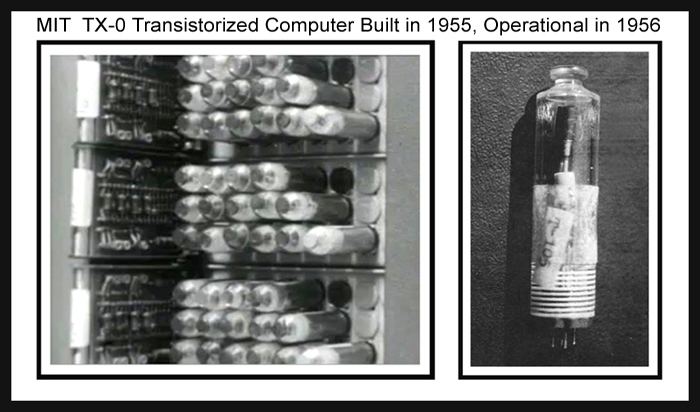 | ||
The TX-0, for Transistorized Experimental computer zero, but affectionately referred to as tixo (pronounced "tix oh"), was an early fully transistorized computer and contained a then-huge 64K of 18-bit words of magnetic core memory. The TX-0 was built in 1955 and went online in 1956 and was used continually through the 1960s at MIT. The transistorized TX-0 computer used 3600 transistors in its computer's circuitry and had also used the Philco high-frequency surface-barrier transistors in its design. In 1953, Philco had developed the world's first high frequency surface-barrier transistor, which was also the first transistor that was suitable for high speed computers. The TX-0 and its direct descendant, the original PDP-1, were platforms for pioneering computer research and the development of what would later be called computer "hacker" culture.
Contents
Background
Designed at the MIT Lincoln Laboratory largely as an experiment in transistorized design and the construction of very large core memory systems, the TX-0 was essentially a transistorized version of the equally famous Whirlwind, also built at Lincoln Lab. While the Whirlwind filled an entire floor of a large building, TX-0 fit in a single reasonably sized room and yet was somewhat faster. Like the Whirlwind, the TX-0 was equipped with a vector display system, consisting of a 12" oscilloscope with a working area of 7 by 7 inches connected to the 18-bit output register of the computer, allowing it to display points and vectors with a resolution up to 512×512 screen locations.
The TX-0 was an 18-bit computer with a 16-bit address range. First two bits of machine word designate instruction and remaining 16 bits are used to specify memory location or operand for special "operate" instruction. First two bits could create four possible instructions, which included store, add, and conditional branch instructions as a basic set. The fourth instruction, "operate", took additional operands and allowed access to a number of "micro-orders" which could be used separately or together to provide many other useful instructions. An "add" instruction took 10 microseconds.
Wesley A. Clark designed the logic and Ken Olsen oversaw the engineering development.
Development
With the successful completion of the TX-0, work turned immediately to the much larger and far more complex TX-1. However this project soon ran into difficulties due to its complexity, and was redesigned into a smaller form that would eventually be delivered as the TX-2 in 1958. Since core memory was very expensive at the time, several parts of the TX-0 memory were cannibalized for the TX-2 project. After a time, the TX-0 was no longer considered worth keeping at Lincoln Lab, and was "loaned" (semi-permanently) to the MIT Research Laboratory of Electronics (RLE) in July 1958, where it became a centerpiece of research that would eventually evolve into the MIT Artificial Intelligence Lab and the original computer "hacker" culture.
Delivered from Lincoln Laboratory with only 4K of core, the machine no longer needed 16 bits to represent a storage address. After about a year and a half, the number of instruction bits was doubled to four, allowing a total of 16 instructions, and an index register was added. This dramatically improved programmability of the machine, but still left room for a later memory expansion to 8K (the four instruction bits and one-bit indexing flag left 13 bits for addressing). This newly modified TX-0 was used to develop a huge number of advances in computing, including speech and handwriting recognition, as well as the tools needed to work on such projects, including text editors and debuggers.
Meanwhile the TX-2 project was running into difficulties of its own, and several team members decided to leave the project at Lincoln Lab and start their own company. After a short time selling "lab modules" in the form of simple logic elements from the TX-2 design, the newly formed Digital Equipment Corporation (DEC) decided to produce a "cleaned up" TX-0 design, and delivered it in 1961 as the PDP-1. A year later, DEC donated the engineering prototype PDP-1 machine to MIT. It was installed in the room next to TX-0, and the two machines would run side-by-side for almost a decade.
Significant pieces of the TX-0 are currently on display in the Library at Lincoln Laboratory. The library is only accessible to Lincoln Lab employees. In 1983, the TX-0 was still running and is shown running a maze application in the first episode of Computer Chronicles.
